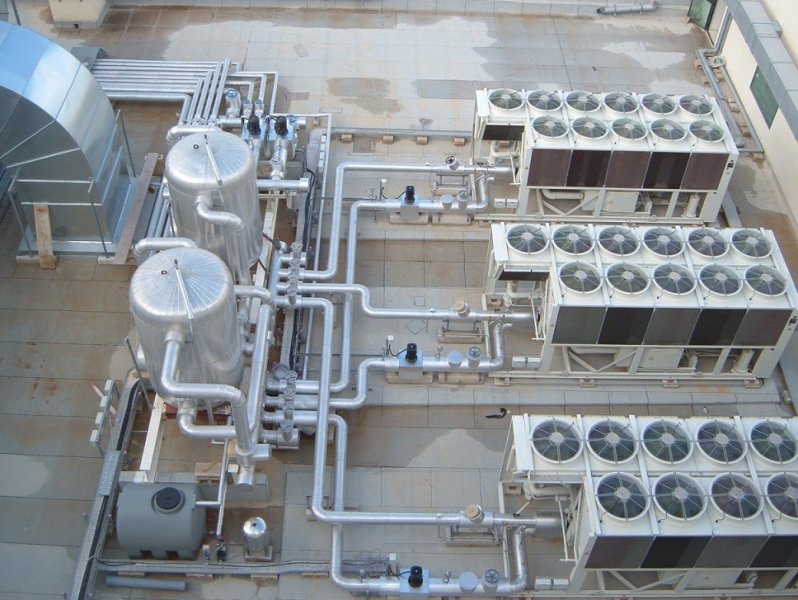High-rise buildings dominate the skylines of modern cities, standing as marvels of engineering and architecture. These towering structures are home

Introduction
Installation of VRF systems in commercial buildings has been a popular HVAC solution in China, Japan, and Europe for decades. Yet this trend is just gaining traction in North America. At the same time, these systems are becoming increasingly popular, particularly in large commercial buildings. Thanks to the plethora of benefits they offer to commercial spaces.
For starters, VRF systems don’t consist of a large, noisy central unit pumping out air to the entire space. Instead, they comprise many smaller handling units that can be independently controlled. This operation model offers a certain level of flexibility and superior energy efficiency.
Surprisingly, those aren’t the only benefits for commercial use offered by these systems. Here are all the benefits you’ll get from installing a VRF system in your commercial building!
Advantages of VRF Systems
A VRF system consists of a louder condenser that is usually stored in a mechanical room or outside. But the smaller air handling units stored inside are quieter than those linked to a large central unit. As a result, they produce low noise during use, making them ideal for work environments where noise can be disruptive. Simply put, VFR systems don’t generate loud noise that can disrupt businesses.
Another major benefit commercial property owners enjoy from VRF systems is that they’re energy-efficient. Specifically, VRF system design supplies the exact amount of refrigerant to individual air handling.
More notably, it supplies the refrigerant to the air handlers depending on the existing conditions of each room. Besides, VRF systems don’t operate at a single speed (OFF/ON) like traditional HVAC design. Instead, the VRF system design ensures that the air handlers operate at varying speeds. This helps to minimize energy waste, thus ensuring the systems run at a lower capacity and less frequently. While keeping the indoor space comfortable for the occupants.
In addition, Commercial VRF systems tend to capture heat during the cooling process. Afterward, this heat is used in other spaces within the building where warmer temperatures are needed. This will also reduce energy waste, hence resulting in significant energy savings and lower utility bills over time.
A commercial VRF system also consists of a compressor unit that identifies the needs of each zone of the building effectively. This ensures that it delivers the exact amount of cooling needed for each air handler. More notably, this precise airflow eliminates hot or cold spots sometimes linked to conventional HVAC units. Also, these systems get rid of humidity issues, providing consistent comfort to the building.
Better still, VRF systems allow you to cool and heat various parts of the building concurrently. That way, you can create different zones with unique temperature settings based on comfort preferences & cooling/ heating needs.
To sum things up, VRF systems are suitable for providing more consistent comfort within a commercial space or office building. Consequently, the employees will be healthier, happier, and more productive.
Typically, VRF systems don’t need ductwork and use relatively smaller air handling units. For those reasons, their installation process is less disruptive and faster. Besides, this offers you more flexibility for installing the handlers and eliminates the need to use ceiling and wall space for large ducts. This is such a great option for an HVAC solution, especially if you don’t want to add ductwork into high ceilings. Even better, it lowers the cost of replacing and maintaining the ductwork.

Another benefit of VRF systems in commercial buildings is that they have a compact and flexible design. This eliminates the need for large spaces to house your cooling and heating equipment. Besides, they don’t include components like pipes, water pumps, and distribution fans. Therefore, they’ll have a much simpler installation process and take up less space. That is a big plus, especially for commercial buildings in California with small office spaces.
Commercial VRF systems experience fewer breakdowns compared to their traditional HVAC counterparts. Their parts have less stress since they run under partial load conditions. Similarly, VRF systems only run when needed.
VRF technology works exceptionally well in commercial buildings that need varying temperatures/ zoning in different spaces. This is particularly useful for temperature-sensitive commercial applications.
Smart technology is another incredible benefit associated with VRF system installation in commercial buildings. For instance, some VRF units allow you to set temperature settings in various zones with your phone. So, if you are managing a commercial establishment, this will eliminate the need of buying cost building management software.
Conclusion
All things considered, VRF systems provide commercial property owners with several benefits. More notably, they provide commercial spaces with energy-efficient MEP design without compromising occupant comfort. Besides, they take up less space and offer the convenience of quiet operation.
However, if you are considering installing a VRF systems in commercial buildings, make sure you contact a VRF expert from Innodez Design & Engineering. Our team works closely with commercial property owners and building managers to choose the best equipment options and VRF system design.
About Author
InnoDez